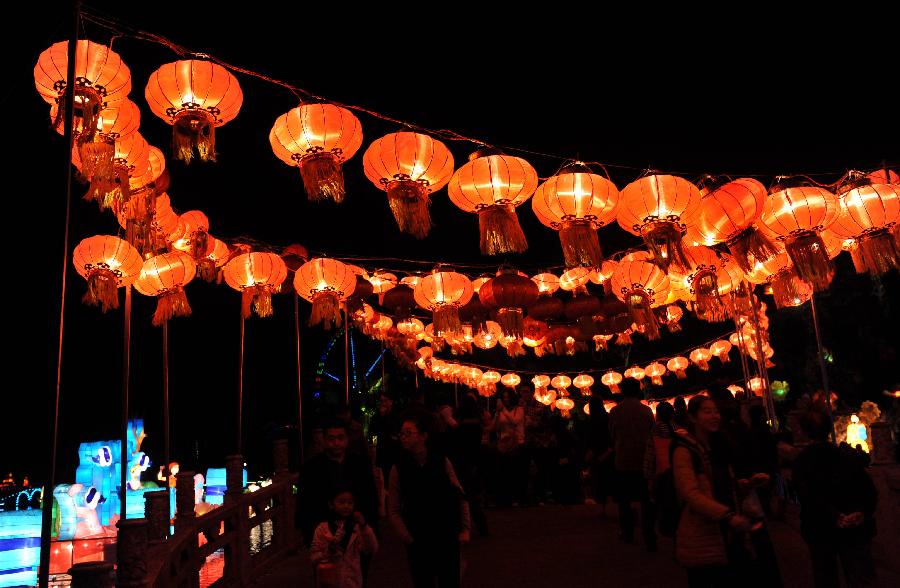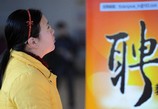
JINAN, Feb. 24 (Xinhua) -- Wang Chenfu has spent nearly four decades growing wheat. Being a traditional farmer most of his life, he is thrilled at the sight of how technology has helped increase production on his land.
"Thanks to new fertilizer techniques, wheat yield per mu (0.067 hectare) now reaches 550 kg. I never would have dreamed of that," said the 55-year-old villager of Yishui county in east China's Shandong Province.
The land in Wang's village used to be sterile, due to high levels of phosphorus. When he first learned to farm, grain output per mu in China was less than 100 kg. Now, average yield for each unit is 330 kg per mu.
Technology breakthroughs have helped bring about the more than five-fold surge in productivity for Wang. In 2011, Yishui county started to promote soil testing and accurate fertilization. On average, wheat output per mu gained another 50 kg.
"In 2012, the planting area of wheat in our county shrank by almost 10,000 mu. Due to new fertilizing methods, Yishui's wheat output totaled 156 million kg, rising by 3 million kg from the previous year," said Meng Guoqing, a technology official at the county's agricultural bureau.
Meng's comments reveal a reality that China is facing.
As rapid urbanization and industrialization squeezes farmlands, technology breakthroughs are deemed as a way out to protect farmers' income and feed the country's population.
For ten years in a row, the government has issued its first annual policy documents targeting rural problems. In the recent two years, it particularly underlined the importance of technology in boosting rural development.
In 2012, the first policy document focused on speeding up technological innovation. This year, it highlighted developing modern agriculture to strengthen the vitality of rural areas.
In China, contribution of science and technology to agricultural growth rose to 54.5 percent in 2012, according to Chen Chuanhong, an official in charge of rural affairs under the Ministry of Science and Technology.
Meanwhile, farming activities using machinery is 57 percent, while more than 95 percent of the farmland nationwide is sown with superior strains, Chen said.
"Breeding is critical to enhancing agricultural productivity growth. In Shandong, selective seeds can contribute 30 to 40 percent of grain output growth. Technological progress will be the main driver for more food production," said Liu Jianjun, a wheat breeding expert with Shandong Academy of Agricultural Sciences.
The new wheat strain "Jimai 22" nurtured by Liu and his colleagues set a record of 789.9 kg per mu for China's winter wheat output, and marked the country's most planted variety.
"'Jimai 22' is a hybrid seed. We crossed a lot of elite varieties to get it. 'Jimai 22' is strongly disease and lodging resistant, which helps to improve productivity," said Liu.
Li Zuqi, 61, has 30 mu of land on which he grows "Jimai 22." With the yield per mu hitting 755.2 kg last year, he was crowned "King of wheat" by his neighborhoods.
"No matter how times change, nothing can give us more confidence than having our barns heaped with grain. As the old saying goes, 'with grain in our hands, there is no need to panic,'" said Li.
However, experts said there is still room to improve the application of agricultural technologies.
A slew of research results have not been put into use in the field, restricted by inefficient promotion, farmers' poor education levels and fragmented operation styles, said Qin Qingwu, a Chinese Association of Agricultural Economics member.
Compared with developed countries, where contribution of science and technology to agricultural growth reached 70 to 80 percent, Chinese farmers still lag far behind, according to Qin.
"Chinese farmers work very hard and are very meticulous. That's good. As China's agriculture gains scale and becomes more intensive, technologies will play a bigger role in boosting agricultural development and benefit farmers," Qin concluded.
















 Provocative propaganda on environmental protection leaded by Chen Guangbiao
Provocative propaganda on environmental protection leaded by Chen Guangbiao


![]()
